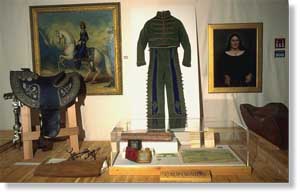 |
 |
|||
|
California on the Eve - Californios
Spanish explorers came in search of strategic ports and the mythical gold of El Dorado. Real attempts at colonization began 1769. One Spanish soldier declared: For Glory, God, and Gold. We came here to serve God, but also to get rich. The Spanish established missions, pueblos and presidios. The missions took over Indian lands, and introduced European practices of agriculture and ranching. The Spanish priests compelled the "neophyte" Indians to convert to Catholicism. Father Francisco Palou stated: We rejoiced to find so many pagans upon whom the light of our holy faith was about to dawn. In 1834 the Spanish Mission lands were seized and secularized. Mexican officials in California awarded huge grants of mission lands to favored individuals. Great ranching empires were created, and huge cattle herds ranged over the land. These ranchers were known as Californios, members of great land-holding families. Mariano Vallejo stated: We were the pioneers of the Pacific coast, building towns and Missions while General Washington was carrying on the War of the Revolution. We often talk together of the days when a few hundred large Spanish ranches and Mission tracts occupied the whole country from the Pacific to the San Joaquin. Rancho life was good for the owners. They lived a leisurely lifestyle dedicated to family and tradition. But most Californios were poor ranch hands who maintained herds of cattle. Vast numbers of Indians provided the hard labor of the ranching, working as vaqueros and servants, toiling under serf-like conditions. Cowhides represented a kind of "gold" to Californios, who called them California Banknotes. They traded hides with Yankee trading-ship captains for household items and luxury goods. Mexican-American War When war erupted, Andres Pico led the fight against the Americans in California. Pico eventually surrendered to John Fremont in January 1847. Pico signed the Cahuenga Capitulation, the treaty that ended hostilities in California a full year before the war was over in Mexico. Top: Californios, Photo by Christopher Richard Nature | Californio | California Indian |
||||
|
||||
